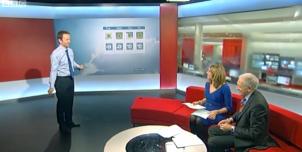Full Freeview on the Emley Moor (Kirklees, England) transmitter
| Google Streetview | Google map | Bing map | Google Earth | 53.611,-1.666 or 53°36'41"N 1°39'57"W | HD8 9TF |
The symbol shows the location of the Emley Moor (Kirklees, England) transmitter which serves 1,550,000 homes. The bright green areas shown where the signal from this transmitter is strong, dark green areas are poorer signals. Those parts shown in yellow may have interference on the same frequency from other masts.
_______
Digital television services are broadcast on a multiplexes (or Mux) where many stations occupy a single broadcast frequency, as shown below.
64QAM 8K 3/4 27.1Mb/s DVB-T MPEG2
DTG-12 QSPK 8K 3/4 8.0Mb/s DVB-T MPEG2
H/V: aerial position (horizontal or vertical)
Which Freeview channels does the Emley Moor transmitter broadcast?
If you have any kind of Freeview fault, follow this Freeview reset procedure first.Digital television services are broadcast on a multiplexes (or Mux) where many stations occupy a single broadcast frequency, as shown below.
64QAM 8K 3/4 27.1Mb/s DVB-T MPEG2
DTG-12 QSPK 8K 3/4 8.0Mb/s DVB-T MPEG2
H/V: aerial position (horizontal or vertical)
Which BBC and ITV regional news can I watch from the Emley Moor transmitter?

BBC Look North (Leeds) 1.9m homes 7.4%
from Leeds LS9 8AH, 22km north-northeast (22°)
to BBC Yorkshire region - 56 masts.

ITV Calendar 1.9m homes 7.4%
from Leeds LS3 1JS, 22km north-northeast (16°)
to ITV Yorkshire (Emley Moor) region - 59 masts.
All of lunch, weekend and 80% evening news is shared with Belmont region
Are there any self-help relays?
| Derwent B | Active deflector | 74 homes | |
| Derwent C | Active deflector | (second level) | |
| Dunford Bridge | Active deflector | 14 km S Huddersfield | 15 homes |
| Hmp Leeds | Transposer | 30 homes | |
| Thixendale | Transposer | 25 km ENE York | 40 homes |
How will the Emley Moor (Kirklees, England) transmission frequencies change over time?
| 1956-80s | 1984-97 | 1997-98 | 1998-2011 | 2011-13 | 5 Feb 2020 | ||||
| VHF | B E T | B E T | B E T | B E T | W T | ||||
| C10 | ITVwaves | ||||||||
| C32 | com7 | ||||||||
| C33 | SDN | ||||||||
| C34 | com8 | ||||||||
| C36 | ArqA | ||||||||
| C37 | C5waves | C5waves | |||||||
| C39 | _local | ||||||||
| C41 | C4waves | C4waves | C4waves | BBCB | BBCB | ||||
| C44 | BBC1waves | BBC1waves | BBC1waves | D3+4 | D3+4 | ||||
| C47 | ITVwaves | ITVwaves | ITVwaves | BBCA | BBCA | ||||
| C48 | ArqB | ArqB | |||||||
| C51tv_off | BBC2waves | BBC2waves | BBC2waves | SDN | |||||
| C52tv_off | ArqA | ||||||||
| C55tv_off | com7tv_off | ||||||||
| C56tv_off | LLS |
tv_off Being removed from Freeview (for 5G use) after November 2020 / June 2022 - more
Table shows multiplexes names see this article;
green background for transmission frequencies
Notes: + and - denote 166kHz offset; aerial group are shown as A B C/D E K W T
waves denotes analogue; digital switchover was 7 Sep 11 and 21 Sep 11.
How do the old analogue and currrent digital signal levels compare?
| Analogue 1-5 | 870kW | |
| SDN, ARQA, ARQB, BBCA, D3+4, BBCB | (-7dB) 174kW | |
| com7 | (-12dB) 54.8kW | |
| com8 | (-12.3dB) 51.2kW | |
| Mux 1*, Mux 2*, Mux B*, Mux C* | (-19.4dB) 10kW | |
| Mux A*, LLS | (-22.4dB) 5kW | |
| Mux D* | (-23.4dB) 4kW |
Which companies have run the Channel 3 services in the Emley Moor transmitter area
|
|
Saturday, 2 June 2012
John Archer: The reason for the "low" power of 87kW is because Pontop Pike uses C48 for one of its pre-switchover channels. It will vacate the channel on 12th September when the power of Emley will increase.
The Digital UK predictor thinks that Pontop's current signals are "good" for you, except for C48. So this is probably your problem.
As a temporary measure, until September, you could try tuning to C42 which is the same multiplex from Bilsdale or C53 which is likewise from Pontop.
| link to this comment |
J
John Archer8:53 PM
Northallerton
John Archer: Thank you Dave Lindsay for your helpful reply.
| link to this comment |
John's: mapJ's Freeview map terrainJ's terrain plot wavesJ's frequency data J's Freeview Detailed Coverage
Tuesday, 5 June 2012
Thursday, 7 June 2012
T
Ted Bell4:28 PM
The digital signal has in the last week or so been very poor. After the switch over last September our signal improved and every freeview station was clear and a good picture, but other than BBC 1/2 AND ITV the picture is subject to breaking and sometimes there is no signal at all. It does not appear to be my aerial. Has the signal strength changed from the transmitter?
| link to this comment |
Robert Hill
8:20 PM
8:20 PM
Ted Bell,everything here usual strength and quality, at the time of posting.In fact, everything as been OK since switchover.
| link to this comment |
Friday, 8 June 2012
R
Ross4:44 PM
The signal quality on the HD channels seem to be fluctuating this afternoon, whereas the non HD channels are fine. Can anyone suggest why the HD channels might be affected in this way?
| link to this comment |
Thursday, 21 June 2012
R
Ross10:23 AM
Surprised that nobody has answered my query, and indeed there seems very little activity here at the moment. That said, the signal problem on the HD channels seems a lot better now, which does make me wonder if they were carrying out some work we are not being told about. Is the 4G roll out planned for next year going to require any retuning for those who take their signal from Emley Moor?
| link to this comment |
M
Mark Fletcher11:17 PM
Barnsley
Ross.No there should be no major retunes for Emley Moor in 2013 concerning 4G as such,as the highest frequency currently in use at Emley Moor is ArqA on frequency 52 although Local TV if implemented will use frequency 56.However come 2020 there is the possibility that the 700mhz frequencies could be cleared (800mhz frequencies will be cleared for good of TV broadcasts during 2013) also for 4G services and by then Emley Moor's commercial multiplexes ArqA (fr 52) and SDN (fr 51) will have to relocate elsewhere.If that 2020 scenario did take effect then Emley Moor could become either a group A,K or most likely remaining a group B transmitter but remaining most likely on horizontal polarisation.Once the 2020 ? effect becomes more transparent concerning Emley Moor then we will all know the eventual possibilities of realigned multiplexes here as such.
| link to this comment |
Mark's: mapM's Freeview map terrainM's terrain plot wavesM's frequency data M's Freeview Detailed Coverage
Friday, 22 June 2012
R
Ross10:20 AM
Mark, Thanks for that - most helpful. I have been told that the clearance of the 700 MHz spectrum is by no means a done deal at the present time, so I guess we wait and see.
| link to this comment |
M
Mike Dimmick11:28 PM
Ross: The proposal on the table at an international level is to make broadcasting and mobile data 'co-primary' from 2015. That would mean countries would be allowed to launch mobile phone services in 700-800MHz as long as they co-ordinated it with each other and with broadcasting.
Ofcom's starting position does seem to be to reduce the broadcasting spectrum still further. Their consultation Ofcom | Securing long term benefits from scarce spectrum resources - A strategy for UHF bands IV and V has recently closed, but they haven't published any responses yet.
Co-primary does pose a problem because TV multiplexes use 8 MHz bandwidth, while LTE uses multiples of 1.4, 3, 5, 10, 15 or 20 MHz, ideally 20 MHz for maximum speeds. Within the band defined - it probably would be a new band as the US-defined bands are weird and have gaps! - the spacing between downlink and uplink channels is supposed to be fixed. (The US bands can only support 5 or 10 MHz because of this.) That would probably make fitting LTE in around TV transmissions effectively impossible.
The specifications do allow for Time-Division Duplexing, where signals from phone to tower use the same frequency as from tower to phone, rather than Frequency-Division Duplexing, where the phone-to-tower transmissions are on different frequencies from tower-to-phone. At present, though, the TDD bands are all above 1800MHz, and there aren't many deployments. All existing UK phone networks use FDD.
| link to this comment |
Select more comments
Your comment please!





